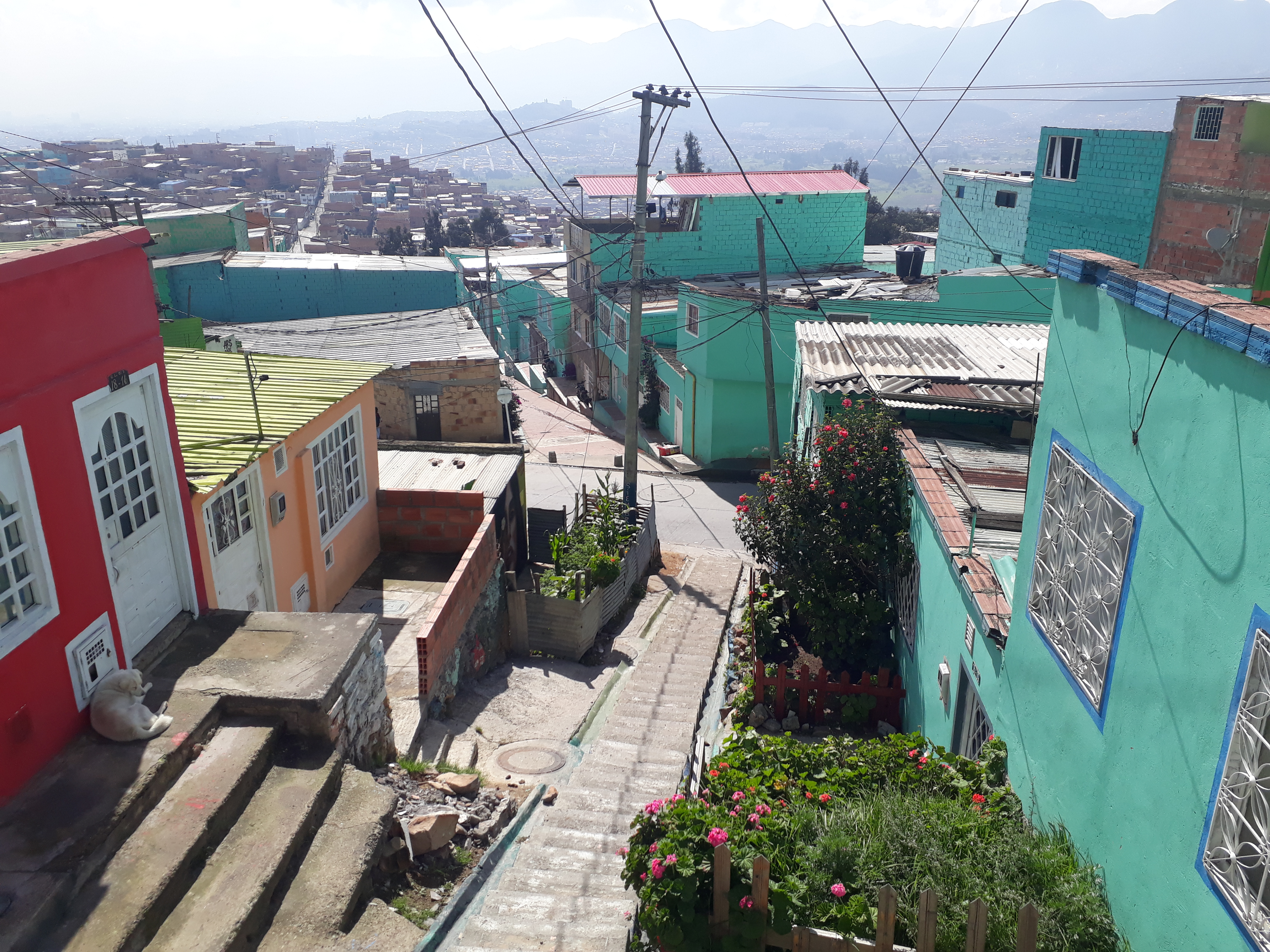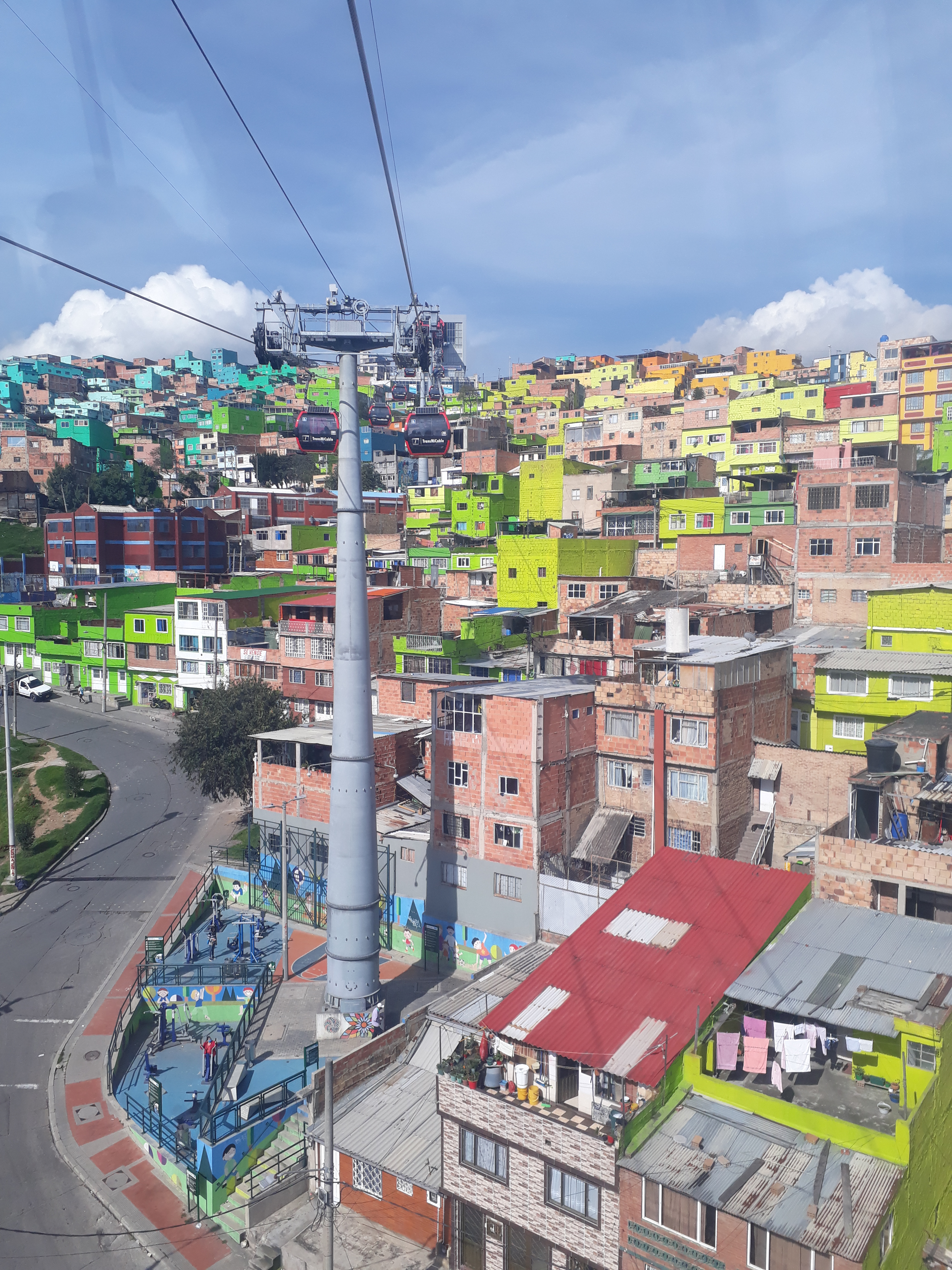How can colour contribute to fostering urban justice?
14 min. read
A summary examining the potential of so-called “placemaking” interventions in terms of strengthening urban justice, using the placemaking strategy of the Colombian capital Bogotá as an example.
Silja Marie Kessler (Master Student at Utrecht University)*
The question at the title of this article was part of a qualitative study conducted at Utrecht University as part of the master’s program in International Development Studies. The study draws insights from the case of a state-led placemaking strategy, HabitARTE, a placemaking program implemented in Bogotá, Colombia. Based on the premise that artistic interventions can be a powerful driver of urban regeneration with social, economic, and environmental benefits, the Bogotá Municipality launched HabitARTE to improve social inclusion and beautify public spaces and facades in informal settlements with colourful murals.
Figure 1: Painted facades after HabitARTE intervention (Photo: Jaime Hernández-Garcia)
Since little has been published about the HabitARTE program after its end in 2019, this research aims to evaluate the program through the case of the informal settlement of “Manitas” in Bogotá (see figure 2). Semi-structured interviews with residents served as key information to shed light on residents’ perception of the program.
Figure 2: Aerial view of Manitas neighborhood after implementation of HabitARTE intervention (Open Street Maps)
The research analysed the potential to promote social justice in the city by empowering the local community. While recognising that placemaking is only one of many approaches, such as improving access to public transportation and social infrastructure, its implementation can contribute to strengthening urban justice. According to Susan Fainstein's concept of the just city, the key to just development lies in democracy, diversity, and equity (see Fainstein, 2010). Whereas, Fainstein argues that while the “values of equity, diversity, and democracy may be in conflict, [..] equity takes primacy, as she argues that policy should give priority to action that benefits the less privileged" (for further information see Spatial Justice blog). Citizen participation and involvement in urban development processes and placemaking can only contribute to justice if residents have a voice in shaping these processes and if those processes enrich their livelihood. Although placemaking interventions are widely celebrated in urban studies for engaging civil society in planning processes, the use of placemaking as a tool to foster urban justice requires critical reflection. Placemaking interventions should neither be romanticised and nor should they be presented as an ever-functioning instrument for improving neighbourhoods. Here, I provide some notes for critical reflection on ‘just’ development, based on the analysis of HabitARTE.
When both financial and human resources are scarce, placemaking brings many advantages, as it is a small-scale resource and budget efficient alternative to traditional planning. However, the top-down implementation of HabitARTE left little opportunity for adequate citizen participation. Although the city government’s strategy intended to promote inclusion and participation and aimed to strengthen place attachment, neighbourhood formation, and social cohesion, the implementation caused adverse side effects, as the interviews showed. Due to the imposition of the strategy by the municipality, residents were not allowed to choose colours or motives, nor to object and intervene or to choose additional types of interventions, thus were not involved in the distribution of resources. Although the municipality intended to establish trust through the action-based strategy and its promise of rapid change, this failed, according to the interview findings.
Moreover, when considering the question of aesthetics: Who determines the aesthetics, themes, styles, and colours of the artwork? From the interviews, it is evident that the city government ignored local identity and instead pushed it aside to make way for larger-scale artworks, that are best visible from a distance away from the neighbourhood. Accordingly, the artistic interventions contribute to the neighbourhood’s assimilation to more affluent areas of the city. Consequently, the program can be seen as a municipality driven beautification strategy to make the neighbourhood more attractive to outsiders. Therefore, it becomes critical to clarify for whom the project was designed and for whom it is intended to benefit.
A radical interpretation is that the municipality holds a negative interpretation of urban informality and imposes the strategy because they assume to know the needs of the residents. As a result, the stigmatisation is exacerbated rather than dissolved, and HabitARTE’s failed strategy continues to marginalise communities while potentially weakening existing communities and local initiatives. Given these factors, HabitARTE can be seen as a missed opportunity to identify, support, and strengthen existing and new cultural initiatives in an urban environment where creativity, ingenuity, and community engagement are at the core of the local identity.
Accordingly, while the underlying principle - the art-based interventions - can be perceived as an encouraging strategy to foster citizens empowerment, the municipal-driven development implementation was inadequate in transparency, decision-making, procedural openness, and the possibility of process adaptation. Taking Fainstein’s words that all citizens could obtain the benefits of beauty, community, and democracy through the imposition of reason rather than through revolutionary means (cf. Fainstein, 2010), it can be concluded that Bogotá’s HabitARTE strategy cannot be considered an ‘imposition of reason’ as Bogotá’s municipal government used its own’ vision of the good city’ as a benchmark, which did not necessarily match the vision of its inhabitants. Ultimately, the evaluation of the project is a moral judgment and remains a matter of opinion, or rather, depends on who is consulted. Nevertheless, this study revealed that considering Fainstein’s Just City, the implementation of Bogota’s strategy falls short in its potential to obtain a just result.
Some critical reflection notes raise the question of whether local development processes initiated by the state or another ‘top-down’ actor can promote just developments if implemented more democratically. In contrast, from the preceding arguments, it might be assumed that it is better to leave neighbourhood development in the hands of the local community, initiated and organised from the bottom up – since, as argued in this work, they are the local experts. However, as also evident from the interviews, local actors often lack financial and organisational means and must claim these resources from the state. Following this argument leads to the contrary conclusion that the unorganised communities will ultimately remain poor and unorganised if the state does not intervene. In this case, those who have the greatest necessity are excluded, as those who (can) apply for and undertake such projects are often better connected politically or more privileged financially or materially. Therefore, civic participation can also exclude certain members of society, as participation in such interventions usually requires specific financial and social capital. Following on from the discussion of the level at which justice is generated, i.e., where lies the responsibility for achieving urban justice in this research, Fainstein identifies institutions as responsible.
Consequently, the project’s success depends on its process and implementation: on who has decision-making power and who can actively shape the process. Therefore, I conclude that policymakers' ignorance and “inaction" will only exacerbate and worsen inequalities since policymakers must acknowledge obstacles and create opportunities that allow everyone the space to participate and contribute, empowering particularly those who are most vulnerable. Since institutions are responsible and accountable for future just development, such institutions must establish target concepts that specify what justice approach is being followed. In this regard, institutions shall not consider the local community as a homogeneous group, nor should institutions strive for justice for all which is not reachable due to different moral rightness perceptions. In this regard, institutions should not view the local community as a homogeneous group, nor should they strive for justice for all, which cannot be achieved due to different moral conceptions of justice. Since the operationalizations and principles developed by Fainstein are still open to interpretation, the conceptualization of urban justice is of particular interest for further research (see Buitelaar et. al. 2017).
Local governments need to define their justice standards to apply them in order to create strategies to implement the urban justice.
While there is no guarantee of just development, as each case is different and depending on the project or site, unforeseen circumstances may affect project implementation and (long-term) impacts. There are some important general guidelines that can be followed. Resident participation and involvement throughout the process and a comprehensive monitoring strategy remain fundamental. Consequently, key elements that can positively influence placemaking projects include ensuring that ownership is at the local level and giving the local community the opportunity to participate and be actively involved in decision-making.
(Re)building trust is another important element for the success of placemaking projects, as projects can only function if different stakeholders collaborate and cooperate. In this context, it is important to note that placemaking projects should be seen only as a starting point in a neighbourhood improvement process, which must be embedded in a comprehensive strategy with a broad agenda and including a follow-up strategy. If necessary, monitoring and adjusting process steps throughout the entire process is important to ensure long-term, sustainable development that meets citizen’s needs. Returning to the question raised in the heading of this article, arts-based placemaking projects can contribute to more just cities when implemented collaboratively. Beyond questioning the impact of the colour on the wall on citizens’ livelihoods, the more important question to consider is how the colour got on the wall and whether the process and/ or the outcome are just.
Consequently, the process can never be regarded as less important than the outcome when it comes to evaluating urban upgrading according to principles of justice. To conclude, placemaking interventions can be seen as a form of collective catalyst for change and a creator of just urban futures with great potential for strengthening civil society and empowering the most vulnerable populations, but only because, and only when the citizen design them.
References
Buitelaar, E., Weterings, A., & Ponds, R. (2017). Cities, Economic Inequality and Justice: Reflections and Alternative Perspectives (1st ed.). Routledge. https://doi.org/10.4324/9781315269900
Fainstein, S. S. (2010). The Just City. Cornell University Presshttps://www.cornellpress.cornell.edu/book/9780801446559/the-just-city/#bookTabs=4
Fainstein, S. S. (2014). The just city. International Journal of Urban Sciences, 18(1), 1–18. https://doi.org/10.1080/12265934.2013.834643
Rocco, R. (n.d.) Susan Fainstein and the Just City. Spatial Justice Blog. Understanding the spatial dimensions of justice. https://spatialjustice.blog/susan-fainstein-and-the-just-city/
About the author:
*Silja Kessler holds a degree in Urban Planning (TU Dortmund, GER), studied and worked as an urban planner in the field of participatory planning. Her second master’s degree in International Development Studies (Utrecht University, NL) reflects her strong interest in a global perspective in addressing emerging challenges.
Contact:
When you subscribe to the blog, we will send you an e-mail when there are new updates on the site so you wouldn't miss them.






Comments